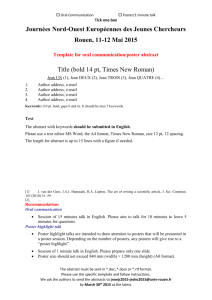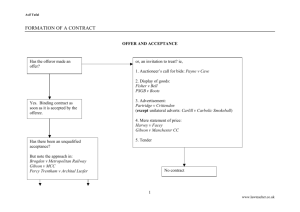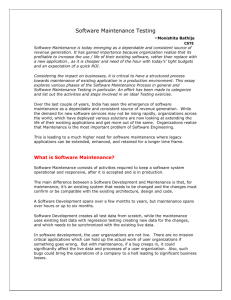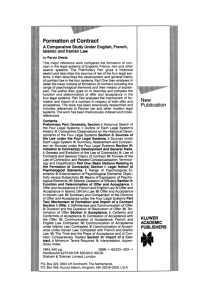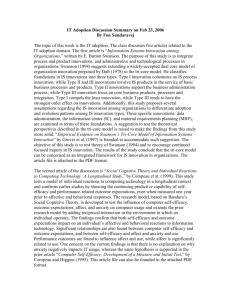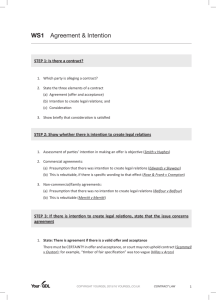abstract template - landscape transformations
advertisement
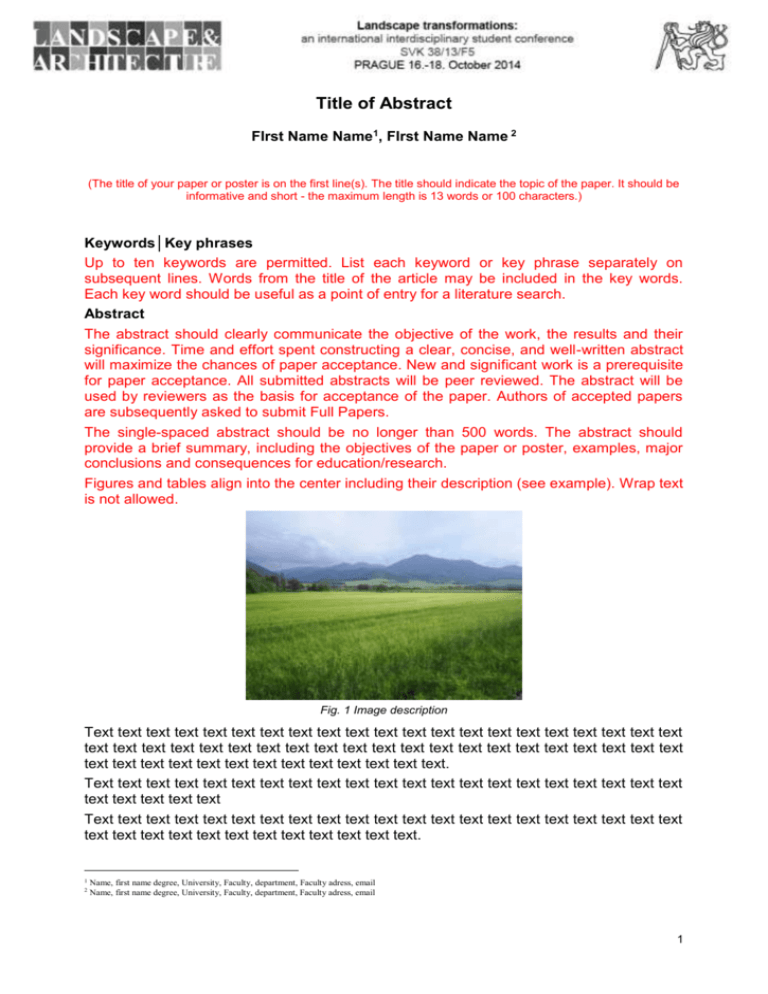
Title of Abstract FIrst Name Name1, FIrst Name Name 2 (The title of your paper or poster is on the first line(s). The title should indicate the topic of the paper. It should be informative and short - the maximum length is 13 words or 100 characters.) Keywords│Key phrases Up to ten keywords are permitted. List each keyword or key phrase separately on subsequent lines. Words from the title of the article may be included in the key words. Each key word should be useful as a point of entry for a literature search. Abstract The abstract should clearly communicate the objective of the work, the results and their significance. Time and effort spent constructing a clear, concise, and well-written abstract will maximize the chances of paper acceptance. New and significant work is a prerequisite for paper acceptance. All submitted abstracts will be peer reviewed. The abstract will be used by reviewers as the basis for acceptance of the paper. Authors of accepted papers are subsequently asked to submit Full Papers. The single-spaced abstract should be no longer than 500 words. The abstract should provide a brief summary, including the objectives of the paper or poster, examples, major conclusions and consequences for education/research. Figures and tables align into the center including their description (see example). Wrap text is not allowed. Fig. 1 Image description Text text text text text text text text text text text text text text text text text text text text text text text text text text text text text text text text text text text text text text text text text text text text text text text text text text text. Text text text text text text text text text text text text text text text text text text text text text text text text Text text text text text text text text text text text text text text text text text text text text text text text text text text text text text text text. 1 2 text text text text text text text text Name, first name degree, University, Faculty, department, Faculty adress, email Name, first name degree, University, Faculty, department, Faculty adress, email 1 Text text text text text text text text text text text text text text text text text text text text text text text text text text text text text text text text text. Text text text text text text text text text text text text text text text text text text text text text text text text text text text text text text text text text. Tab. 1 Table description Text text text text text text text text text text text text text text text text text text text text text text text text text text text text text text text text text. Text text text text text text text text text text Text text text text text text text text text text Text text text text text text text text text text Text text text text text text text text text text Text text text text text text text text text text text text text text text text text text text text text text text text text text text text text text text text text. Acknowledgement The gratitude to people and organizations which contributed to the appearance of the paper should be put before the REFERENCES. References All publications cited in the text should be presented in a list of references following the body text. The list of references should be carefully checked to ensure that the spelling of authors' names and dates are exactly the same as in the text. In the text, refer to the author's name and year of publication, followed, if necessary, by a short reference to the appropriate pages. "as suggested by Forman (1995: 43)." A list of all references should be given at the end of the text, typed in Arial 8-point, single line spacing, with a blank line between each reference cited. Journal Article: Herzog, T. R. and Miller, E. J. (1998) 'The role of mystery in perceived danger and environmental preference', in Environment and Behavior, 30(4), 429-499. Book: Hart, R. (1979) Children's Experience of Place. New York: Irvington. Multi-author books: Meinig, D.W. (1979) The beholding eye: ten versions of the same scene, in Meinig, D.W. (ed.) The Interpretation of Ordinary Landscapes. New York: Oxford University Press, pp.11-32. 2 Internet references: Indicate the url and most recent update of a site.? McCauly, J.D. (1995) Serving GIS Data through World Wide Web, pasture.ecn.purdue.edu/engelb/ncgia96/engel.htm [November 1995] Tables and figures should be numbered in a continuous way in the order of their quotation in the text. In tables we do not use vertical lines. Each table should have a title. Possible footnotes should be marked with an asterisk in the superscript and explained beneath the table. Drawings and photographs Images should be pasted in the text with the resolution 300dpi and the width of the base not bigger than 16 cm. The content should be appropriate to final A5 size of proceedings and printed in black and white. 3






